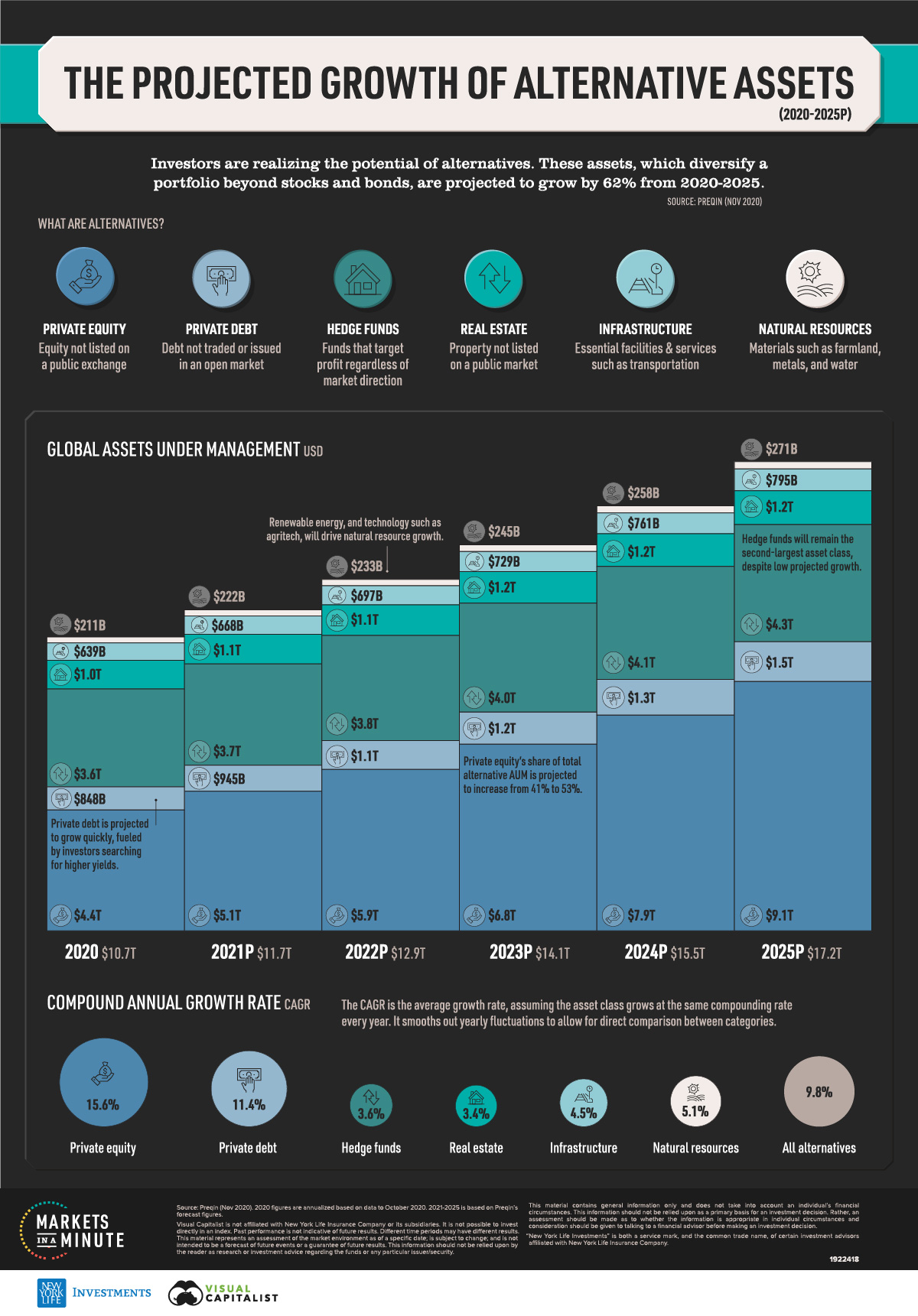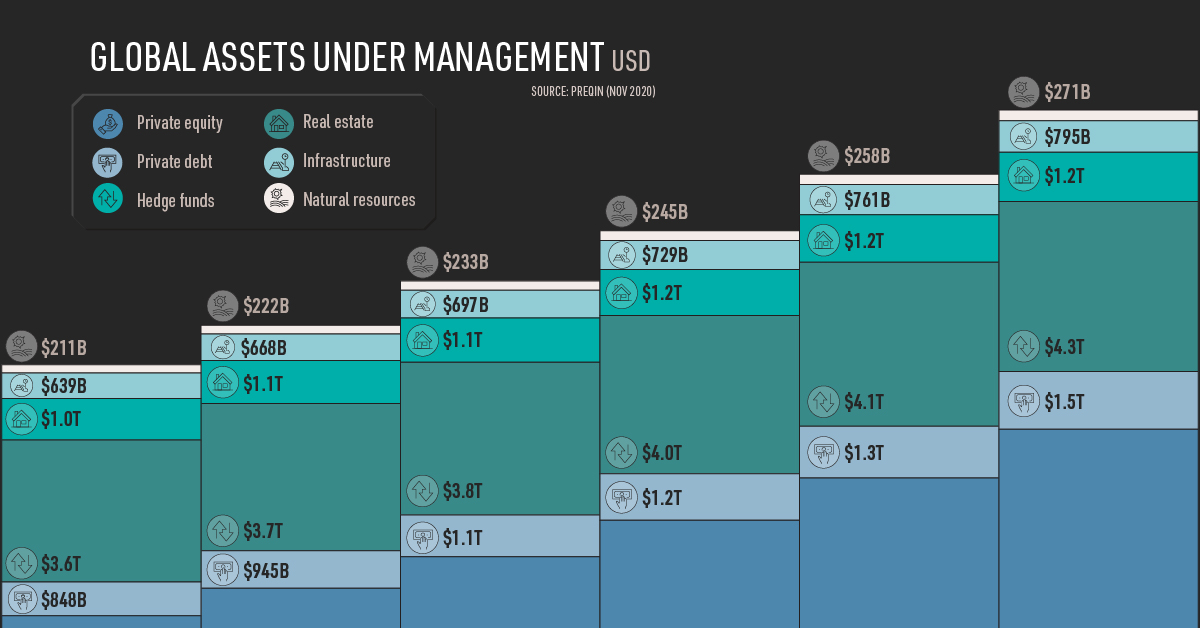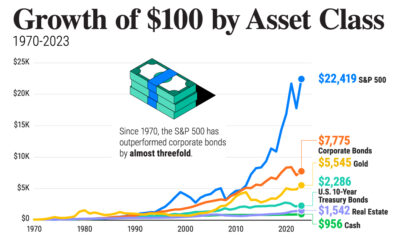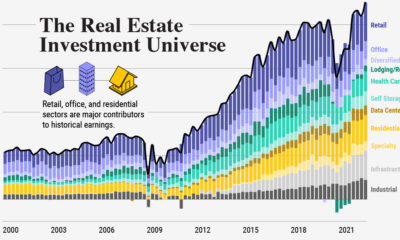This infographic is available as a poster.
The Projected Growth of Alternative Assets
When it comes to investing, the focus is typically on stocks and bonds. However, in recent years, many investors have turned their attention to another opportunity: alternative assets.
In fact, global assets under management (AUM) in alternatives are projected to grow by 62% from 2020-2025. In this Markets in a Minute from New York Life Investments, we explain what alternative assets are and which categories will see the most growth.
What are Alternative Assets?
Alternative assets are investments that fall outside of the traditional asset classes of stocks, bonds, and cash. They are broken up into the following asset classes:
- Private equity: Investing in companies that are not publicly traded or listed on a stock exchange. This can also include the acquisition of public companies by a private investment fund or investor.
- Private debt: Investing in companies in the form of debt as opposed to equity. Private debt is not typically financed by banks, nor traded or issued in an open market.
- Hedge funds: Largely unregulated funds that can invest across a wide range of asset classes and instruments. These funds aim to ‘hedge’ risk and maximize profits regardless of which direction the market moves through long (buy) or short (sell) positions.
- Real estate: The acquisition, financing, and ownership of real estate assets by private investment vehicles, funds, or firms. This includes residential, commercial, and industrial properties both at the time of original listing and when being sold between two parties afterwards.
- Infrastructure: Investment in services and facilities considered essential to the economic development of a society. This includes energy, logistics, telecoms, transportation, utilities, and waste management.
- Natural resources: Investment in the development, enhancement, or production of various types of natural resources. This includes agriculture, renewable energy, timberland, water, and metals.
In contrast to traditional markets, alternative assets are typically less liquid and less regulated.
Global Growth
According to Preqin, all alternative asset classes will see significant growth in global AUM. Here’s how the projections break down from 2020 to 2025:
| 2020 | 2021P | 2022P | 2023P | 2024P | 2025P | CAGR |
| Private equity | 4.4T | $5.1T | $5.9T | $6.8T | $7.9T | $9.1T | 15.6% |
| Private debt | $848B | $945B | $1.1T | $1.2T | $1.3T | $1.5T | 11.4% |
| Hedge funds | $3.6T | $3.7T | $3.8T | $4.0T | $4.1T | $4.3T | 3.6% |
| Real estate | $1.0T | $1.1T | $1.1T | $1.2T | $1.2T | $1.2T | 3.4% |
| Infrastructure | $639B | $668B | $697B | $729B | $761B | $795B | 4.5% |
| Natural resources | $211B | $222B | $233B | $245B | $258B | $271B | 5.1% |
| Total | $10.7T | $11.7T | $12.9T | $14.1T | $15.5T | $17.2T | 9.8% |
Private equity will grow the fastest, and will also see the highest growth in dollar terms. In fact, its proportion of alternative assets’ AUM is expected to rise from 41% in 2020 to 53% in 2025. Preqin predicts that this will be due to both strong performance and asset flows, with 79% of surveyed investors planning to increase their allocation to private equity.
Private debt is also expected to see strong growth. With greater risk appetite than banks, private debt funds could be active in emerging technologies such as pharmaceuticals and the remote working industry. These funds take on higher risk in anticipation of higher yield potential, an attractive proposition for investors amid low interest rates in many areas.
Similarly, investors will likely turn to real estate for its yield potential. Long-leased assets usually offer stable cash flows and indexed rents, making them one of the asset classes that may hedge inflation. However, the industry is projected to have the lowest compound annual growth rate, given the uncertainty facing office and retail spaces post COVID-19.
The Opportunities in Alternative Assets
Outside of investments such as liquid alternatives, alternative assets have typically only been accessible to institutional investors. However, recent regulatory changes by the U.S. Security and Exchange Commission (SEC) mean that private markets are opening up to individual investors if they meet certain criteria.
Alternative assets offer a number of compelling opportunities, including portfolio diversification, lower correlation with public markets, and potential outperformance. In fact, research has found that private equity was the best-performing asset class in a public pension portfolio, based on median annualized returns from 2010-2020.
According to Preqin’s projections, it appears investors are realizing this potential. While stocks and bonds will likely remain central to portfolios, alternative assets can help to broaden investors’ horizons.




 Infographics2 years ago
Infographics2 years ago
 Markets in a Minute2 years ago
Markets in a Minute2 years ago
 Markets in a Minute2 years ago
Markets in a Minute2 years ago
 Infographics2 years ago
Infographics2 years ago
 Markets in a Minute1 year ago
Markets in a Minute1 year ago
 Infographics3 years ago
Infographics3 years ago
 Markets in a Minute2 years ago
Markets in a Minute2 years ago
 Infographics1 year ago
Infographics1 year ago

















